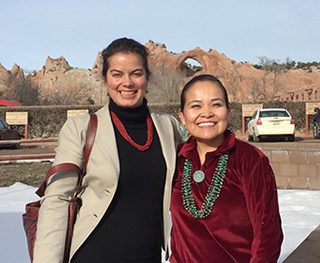
Access to safe drinking water is not universal across the U.S., said Paloma Beamer, Ph.D., during a talk on exposure to environmental contaminants in rural populations.
Center for Indigenous Environmental Health Research investigators Beamer and Jani Ingram, Ph.D., discussed their research during a session on the physical environmental determinants of health at the NIH Rural Health Seminar, November 18, 2021.
During the presentation, Beamer explained that for research in rural communities to be successful, scientists first need to build trust with residents.
Ingram’s presentation focused on arsenic and uranium contamination in drinking water sources in the Western Navajo Nation. According to Ingram, this creates an economic burden for the Navajo people, who must haul clean water.
To learn more about the Center’s work to build trust in Indigenous communities through partnerships, see this Partnerships for Environmental Public Health newsletter.
The day-long seminar, which was co-sponsored by NIEHS, brought more than two dozen speakers who discussed how environmental factors affect rural health.


